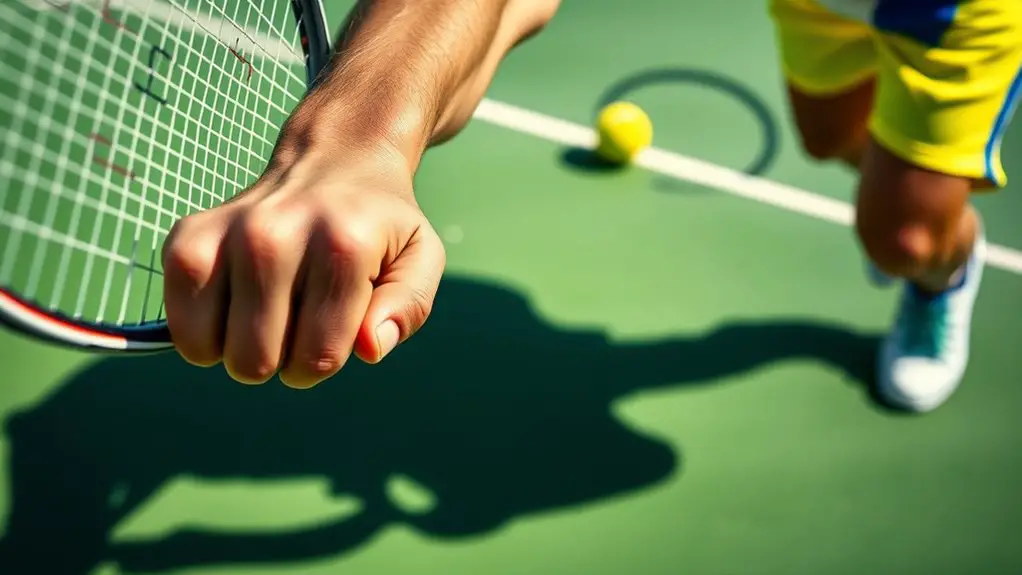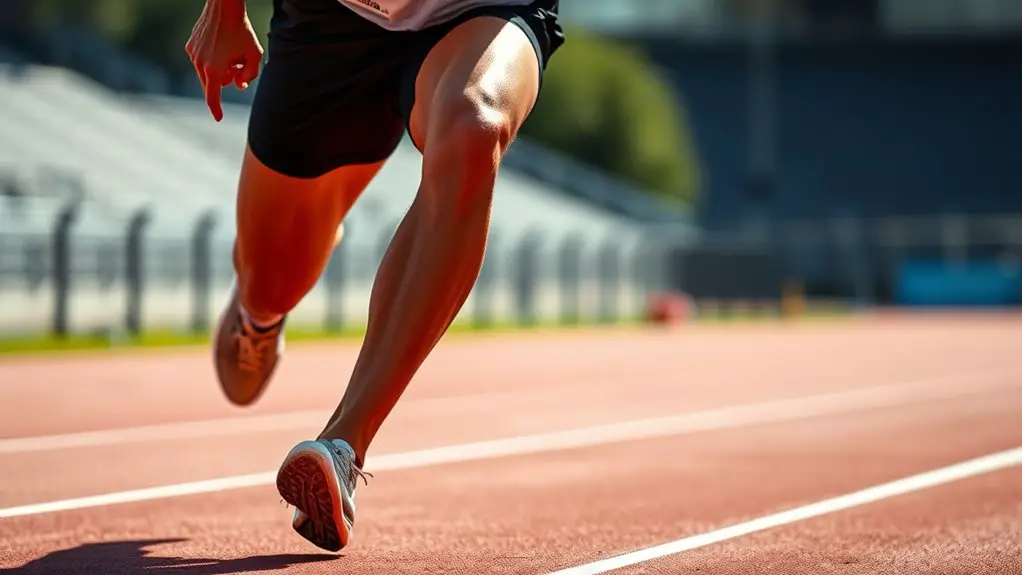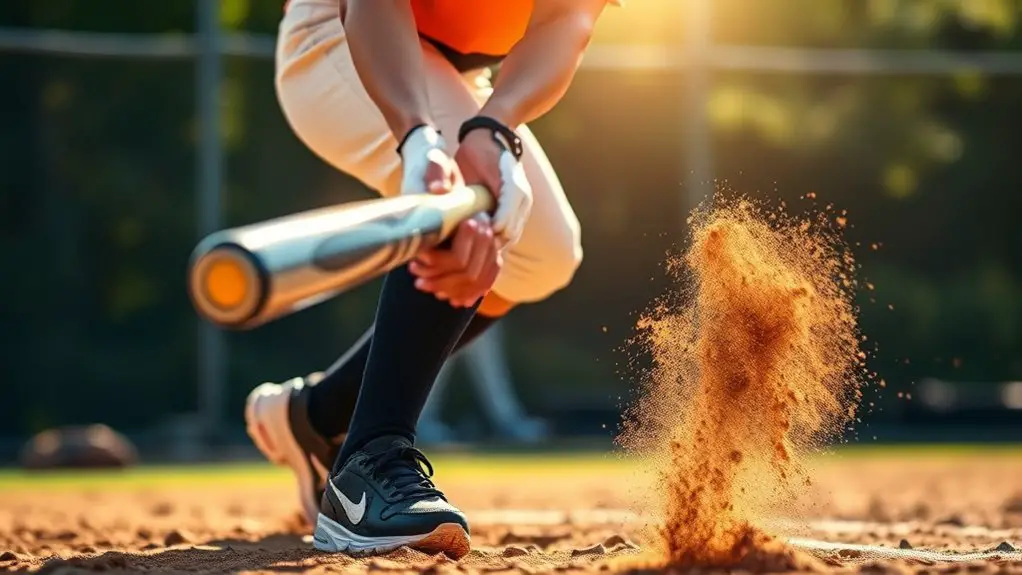Grip strength plays an essential role in your serve accuracy. A stronger grip stabilizes your racket, allowing for better control and consistency during your serve. It enhances your ability to manage spin and precision at impact, which contributes to effective targeting. Improved grip strength also aids in your overall balance and coordination. By focusing on building your grip, you can greatly enhance your serve performance. Want to discover effective training techniques to boost your grip strength?
Understanding Grip Strength
Grip strength plays an essential role in many sports, particularly those involving rackets or clubs. You know that when you can grip firmly, you're more in control, and your performance improves. To enhance your grip strength, integrating forearm workouts and specific grip exercises into your routine is vital. These exercises help develop the muscles that allow you to maintain a powerful hold, ensuring your racket or club doesn't slip during critical moments.
Think of exercises like wrist curls, farmer's walks, or using a grip trainer. They'll not only make your grip stronger but also boost your overall confidence in your sport. The freedom you get from knowing your grip is solid can change how you play, allowing you to focus more on your technique and strategy rather than worrying about losing control. Additionally, proper nutrition plays a crucial role in fueling your muscles for optimal performance, which can further enhance your grip strength. So, embrace these workouts and exercises to elevate your game and enjoy that newfound freedom on the court or field!
The Mechanics of a Serve
A strong grip not only enhances your control but also influences the mechanics of a serve. When you step up to serve, your grip sets the stage for everything that follows. The toss technique is essential; it's all about consistency and placement. A well-executed toss gives you the freedom to swing your racket fluidly, allowing for better timing and precision.
Your serve mechanics begin with your stance, where a firm grip stabilizes your racket and prepares you for the motion. As you toss the ball, your arm should work in harmony with your legs, generating power while maintaining balance. That grip keeps your racket steady, so you can focus on hitting your target. Ultimately, mastering these elements empowers you to serve confidently, transforming your game and elevating your performance on the court. Additionally, a solid grip contributes to enhanced stability during your serve, which is crucial for maintaining balance and control. Embrace the freedom that comes with solid serve mechanics and a reliable toss technique!
How Grip Strength Affects Ball Control
Your grip strength plays an essential role in how well you control the ball during a serve. A stronger grip provides stability, allowing for better precision at the moment of impact. Additionally, it can help you manage the spin on the ball, giving you more versatility in your shots. Moreover, enhancing your grip strength through hangboard training can lead to improved overall performance on the court.
Grip Strength and Stability
While it might seem that technique alone governs ball control, grip strength plays an essential role in stabilizing your hold on the racket. When you've got solid grip endurance, you're better equipped to maintain control during your serves. The right grip strength allows you to feel the racket in your hands, enhancing your connection with the ball. Incorporating stability exercises into your training routine can further boost your grip strength, giving you the freedom to swing without hesitation. These exercises help you develop the necessary strength to resist unwanted movements, ensuring your grip remains firm and reliable. Ultimately, a strong grip leads to more confidence on the court, empowering you to release your full potential with every serve.
Precision During Impact
Precision during impact is essential for executing successful serves, and grip strength directly influences this aspect of ball control. When you have a firm grip, it allows you to connect with the ball more effectively, enhancing your serve performance. Strong grip strength acts as a stabilizing force, ensuring that your racket doesn't twist or slide at the moment of impact. This stability helps you control direction and power, making it easier to hit your target consistently. Additionally, grip strength affects other impact factors, like your ability to adjust to varying ball speeds or spin. By focusing on strengthening your grip, you can improve your overall serve accuracy, giving you more freedom to express your playing style on the court.
Variability in Spin Control
Grip strength considerably impacts your ability to control spin on the ball, making it a critical factor in achieving varied shot outcomes. With the right grip adjustments, you can enhance your spin variation, allowing for more dynamic plays during a match. A strong grip helps you maintain consistent contact with the ball, while a relaxed grip can create unpredictable spins.
Here's a quick overview of how grip strength influences spin control:
| Grip Strength | Spin Variation | Effect on Control |
|---|---|---|
| Weak | Low | Limited control |
| Moderate | Moderate | Balanced control |
| Strong | High | Enhanced control |
| Adjusted | Variable | Unpredictable spins |
The Connection Between Grip Strength and Precision
Although many factors contribute to serve accuracy in sports, grip strength plays an essential role in your overall performance. When you have strong grip endurance and grip coordination, you can maintain better control over your serve. Here's how grip strength enhances your precision:
- Consistency: A strong grip allows you to consistently reproduce the same motion, leading to more accurate serves.
- Control: Enhanced grip coordination gives you the ability to fine-tune your grip pressure, which directly impacts the ball's trajectory and spin.
- Confidence: Knowing you can rely on your grip strength helps you focus on your technique, reducing anxiety during critical moments. Additionally, incorporating specific exercises like Farmers Walk can significantly improve your grip strength, further enhancing your performance.
Training Techniques to Enhance Grip Strength
To boost your grip strength, incorporating resistance band exercises can be a game changer. These bands offer a versatile way to target your hand and forearm muscles. Additionally, using specialized grip strength tools can help you track your progress and enhance your training routine. Moreover, resistance bands provide enhanced strength and muscle activation, which is crucial for improving grip strength effectively.
Resistance Band Exercises
Since developing grip strength is essential for improving serve accuracy, incorporating resistance band exercises into your training regimen can be highly effective. Resistance bands offer a variety of benefits, like enhancing flexibility and building muscle endurance. Here are three resistance band techniques you can try:
- Wrist Flexion: Anchor the band and pull it towards you to strengthen your wrist flexors.
- Finger Extensions: Loop the band around your fingers and open your hand against the resistance to target finger strength.
- Reverse Wrist Curl: Secure the band and extend your wrist upward to engage your forearm muscles.
Grip Strength Tools
When you want to boost your grip strength, using specialized tools can make a significant difference. Grip strength devices like hand grippers, stress balls, or even grip rings are fantastic options to incorporate into your routine. These tools allow you to focus on various grip training techniques, helping you build endurance and power. You can easily integrate them into your daily activities, whether you're watching TV or on a break at work. Plus, they're portable, so you can take them anywhere. By committing to consistent practice with these devices, you'll not only enhance your grip strength but also improve your serve accuracy on the court. Embrace the freedom of movement and power that comes with stronger grips!
Case Studies: Athletes Who Improved Serve Accuracy
Many athletes have successfully enhanced their serve accuracy by focusing on grip strength, demonstrating that this often-overlooked aspect can make a significant difference in performance. Here are three inspiring case studies showcasing how grip strength training transformed serve accuracy:
- Jordan, a tennis player: After incorporating grip strength exercises, he reported a 15% increase in serve accuracy, as confirmed by his performance metrics.
- Maya, a volleyball athlete: She added grip strength routines to her training, leading to improved ball control and a noticeable 20% uptick in targeted serves. Athlete testimonials from her teammates echoed her success.
- Sam, a racquetball player: By focusing on grip strength, he improved his serve consistency, resulting in a dramatic 25% reduction in unforced errors during matches.
These examples illustrate how prioritizing grip strength can empower athletes to achieve their goals and enjoy newfound freedom in their sport!
Common Mistakes and Misconceptions
While grip strength training is vital for improving serve accuracy, athletes often fall prey to common mistakes and misconceptions that can hinder their progress. One of the most persistent common myths is that grip strength alone guarantees better serves. While it's important, it's not the only factor at play. Another grip misconception is that you should only focus on the dominant hand. Neglecting your non-dominant hand can lead to imbalances that affect your overall performance. Some athletes believe that heavy lifting is the only way to build grip strength, but incorporating functional exercises can be just as effective. You might also think that grip training is a one-time effort, when in reality, it requires consistency and ongoing adjustment. By recognizing these pitfalls, you can embrace a more holistic approach to training, freeing yourself to access your full potential on the court. Additionally, integrating exercises like squats and deadlifts can enhance overall strength, contributing to improved grip performance.
Integrating Grip Strength Training Into Your Routine
Recognizing the common mistakes and misconceptions about grip strength is the first step towards effective training. Integrating grip training into your routine can enhance your serve accuracy while promoting overall strength conditioning. Here's how to do it seamlessly:
- Start Simple: Begin with basic exercises like hand grippers or squeezing a tennis ball. This builds a strong foundation.
- Consistency is Key: Aim for at least three sessions a week. Short, focused workouts can yield impressive results over time.
- Mix It Up: Incorporate varied exercises, such as dead hangs or wrist curls, to target different muscle groups and keep it engaging.
Frequently Asked Questions
How Can I Measure My Grip Strength Accurately?
"You can't judge a book by its cover," and that applies to grip strength too! To measure your grip strength accurately, consider using dynamometer testing. This device will give you precise readings of your grip strength. Once you know your baseline, you can start grip strengthening exercises to improve it. Regularly retesting with the dynamometer helps you track your progress and guarantees you're on the right path to achieving your goals.
Does Grip Strength Vary by Sport?
Yeah, grip strength definitely varies by sport. For baseball, you need a strong grip to hold the bat; a solid tennis grip helps with control and power. In golf, a secure grip guarantees better swings. Rock climbing demands a different grip, focusing on endurance and precision. Weightlifting requires a firm grip for safety and effectiveness. Even in martial arts, a strong grip can give you an edge in holds and techniques. It's all about what you're doing!
Can Grip Strength Reduce the Risk of Injury?
Absolutely, grip strength can play an essential role in injury prevention. When you've got a strong grip, you're better equipped to stabilize your joints, reducing the risk of strains and sprains. This not only keeps you safer but also contributes to performance enhancement. With improved grip strength, you'll find that your overall control and efficiency in various activities improve, allowing you to enjoy your pursuits with greater freedom and confidence.
Are There Specific Grip Strength Exercises for Beginners?
If you're looking to build your grip strength, there are some great beginner exercises you can try. Simple tools like grip trainers or stress balls can help you get started. Just squeeze and hold for a few seconds, then release. You can also do wrist curls with light weights. Remember, consistency is key, so incorporate these into your routine. It won't take long before you notice a difference in your strength!
How Often Should I Train Grip Strength for Best Results?
Imagine your hands gripping a sturdy branch as you climb higher toward your goals. To achieve ideal results in grip strength, training frequency is key. Aim for two to three sessions per week, allowing your muscles time to recover and grow. Incorporate various exercises, like hangs and squeezes, to keep things fresh. Remember, consistency is your ally, and with each session, you'll feel your strength soar, giving you the freedom to conquer new challenges.




